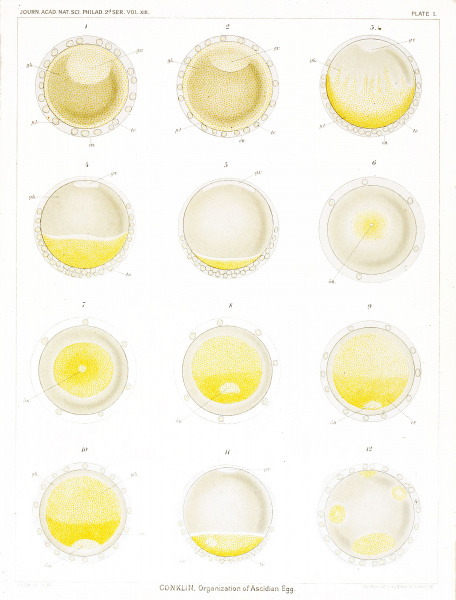File:Conklin 1905 plate01.jpg

Original file (1,521 × 2,000 pixels, file size: 422 KB, MIME type: image/jpeg)
Plate I Figures of the Living Egg of Oynthia partita - Maturation and Fertilization
Fig. 1. Unfertilized egg before the fading of the germinal vehicle, showing central mass of gray yolk, peripheral layer of yellow protoplasm, test cells and chorion.
Fig. 2. .Similar egg after the disappearance of the nuclear membrane, showing the spreading of the clear protoplasm of the germinal vesicle at the animal pole.
Fig. 3. Another egg about five minutes after fertilization, showing the streaming of the peripheral protoplasm to the lower pole where the spermatozoon enters, thus exposing the gray yolk of the upper hemisphere; the test cells are also carried by this streaming to the lower hemisphere.
Figs. 4 and 5. Other eggs -bowing successive stages in the collection of the yellow and clear protoplasm at the vegetal pole; clear protoplasm lies beneath and extends a short distance beyond the edge of the yellow cap.
Figs. 6-10. Successive stages of the same egg drawn at intervals of about five minutes; viewed from the vegetal pole. In fig. 6 the area of yellow protoplasm is smallest, and the sperm nucleus is a small clear area near its center. Figs. 7.-10 show stages in the spreading of this yellow protoplasm until it covers nearly the whole of the lower hemisphere; at the same time the sperm nucleus and aster move toward one side of the yellow cap and the yellow protoplasm begins to collect into a crescent at this side.
Fig. 11. Side view of an egg of about the same stage as fig. 10, showing the eccentric position of the sperm nucleus and a small area of clear protoplasm at the upper pole where the polar bodies are being formed.
Fig. 12. Polyspermic (?) egg, viewed from the vegetal pole, showing four collections of yellow protoplasm around as many sperm (?) nuclei (see p. 24).
| Historic Disclaimer - information about historic embryology pages |
|---|
| Pages where the terms "Historic" (textbooks, papers, people, recommendations) appear on this site, and sections within pages where this disclaimer appears, indicate that the content and scientific understanding are specific to the time of publication. This means that while some scientific descriptions are still accurate, the terminology and interpretation of the developmental mechanisms reflect the understanding at the time of original publication and those of the preceding periods, these terms, interpretations and recommendations may not reflect our current scientific understanding. (More? Embryology History | Historic Embryology Papers) |
- Conklin Figures: Fig 1-2 | Fig 3-6 | Fig 7-8 | Fig 9-12 | Fig 13-16 | Fig 17-20 | Fig 21-24 | Fig 25-26 | Fig 27-33 | Fig 34-35 | Plate I | Plate II | Plate III | Plate IV | Plate V | Plate VI | Plate VII | Plate VIII | Plate IX | Plate X | Plate XI | Plate XII
Reference
Conklin EG. The Organization and Cell-Lineage of the Ascidian Egg (1905) J. Acad., Nat. Sci. Phila. 13, 1.
Conklin 1905 TOC: I. The Ovarian Egg | II. Maturation and Fertilization | III. Orientation of Egg and Embryo | IV. Cell-Lineage | V. Later Development | VI. Comparisons with A.mphioxus and Amphibia | VII. The Organization of the Egg | Summary | Literature Cited | Explanation of Figures
Cite this page: Hill, M.A. (2024, April 25) Embryology Conklin 1905 plate01.jpg. Retrieved from https://embryology.med.unsw.edu.au/embryology/index.php/File:Conklin_1905_plate01.jpg
- © Dr Mark Hill 2024, UNSW Embryology ISBN: 978 0 7334 2609 4 - UNSW CRICOS Provider Code No. 00098G
File history
Click on a date/time to view the file as it appeared at that time.
| Date/Time | Thumbnail | Dimensions | User | Comment | |
|---|---|---|---|---|---|
| current | 15:11, 19 October 2016 |  | 1,521 × 2,000 (422 KB) | Z8600021 (talk | contribs) |
You cannot overwrite this file.
File usage
The following 2 pages use this file:
